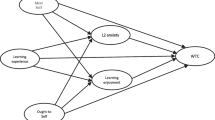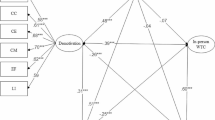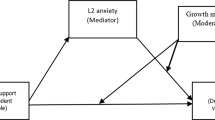Abstract
This study explored the interrelationships between the three components of second language (L2) motivational self system (i.e., ideal L2 self, ought-to L2 self, and L2 learning experience), international posture, L2 anxiety, and willingness to communicate (WTC) using structural equation modeling. Questionnaire data were collected from 1,013 university students in China. The results showed that ideal L2 self was predicted by learning experience, ought-to L2 self, and international posture. Ideal L2 self and ought-to L2 self exerted, respectively, a negative and positive effect on L2 anxiety. L2 WTC was found to encompass two distinct factors: WTC inside and outside the classroom. The former was predicted by L2 anxiety, learning experience, and international posture, whereas the latter had international posture as its only direct predictor. This model marks the first step toward drawing on L2 motivational self system to account for foreign language learners’ communication intention from the perspective of an imagined global community.


Similar content being viewed by others
Notes
The questionnaire is available upon request.
References
Alsagoff, L., McKay, S. L., Hu, G., & Renandya, W. A. (Eds.). (2012). Principles and practices for teaching English as an international language. New York: Routledge.
Brown, T. A. (2006). Confirmatory factor analysis for applied research. New York: Guilford Press.
Byrne, B. M. (1998). Structural equation modeling with LISREL, PRELIS, and SIMPLIS: Basic concepts, applications, and programming. Mahwah: Lawrence Erlbaum Associates.
Cao, Y. (2011). Investigating situational willingness to communicate within second language classrooms from an ecological perspective. System, 39(4), 468–479.
Clément, R. (1986). Second language proficiency and acculturation: An investigation of the effects of language status and individual characteristics. Journal of Language and Social Psychology, 5(4), 271–290.
Clément, R., Baker, S. C., & MacIntyre, P. D. (2003). Willingness to communicate in a second language: The effects of context, norms, and vitality. Journal of Language and Social Psychology, 22(2), 190–209.
Crystal, D. (2003). English as a Global Language (2nd ed.). Cambridge: Cambridge University Press.
Csizér, K., & Kormos, J. (2009). Learning experiences, selves and motivated learning behaviour: A comparative analysis of structural models for Hungarian secondary and university learners of English. In Z. Dörnyei & E. Ushioda (Eds.), Motivation, language identity and the L2 self (pp. 98–119). Bristol: Multilingual Matters.
Dörnyei, Z. (2005). The psychology of the language learner: Individual differences in second language acquisition. Mahwah: Lawrence Erlbaum Associates.
Dörnyei, Z. (2009). The L2 motivational self system. In Z. Dörnyei & E. Ushioda (Eds.), Motivation, language identity and the L2 self (pp. 9–42). Bristol: Multilingual Matters.
Ely, C. M. (1986). An analysis of discomfort, risk taking, sociability, and motivation in the L2 classroom. Language Learning, 36(1), 1–25.
Gardner, R. C. (1985). Social psychology and second language learning: The role of attitude and motivation. London: Edward Arnold.
Ghonsooly, B., Khajavy, G. H., & Asadpour, S. F. (2012). Willingness to communicate in English among Iranian non-English major university students. Journal of Language and Social Psychology, 31(2), 197–211.
Hair, J. F., Black, W. C., Babin, B. J., Anderson, R. E., & Tatham, R. L. (2006). Multivariate data analysis (6th ed.). Upper Saddle River: Prentice Hall.
Higgins, E. T. (1987). Self-discrepancy: A theory relating self and affect. Psychological Review, 94(3), 319–340.
Horwitz, E. K., Horwitz, M. B., & Cope, J. (1986). Foreign language classroom anxiety. The Modern Language Journal, 70(2), 125–132.
Jöreskog, K. G. (1993). Testing structural equation models. In K. A. Bollen & J. S. Long (Eds.), Testing structural equation models (pp. 294–316). Newbury Park: Sage.
Kang, S.-J. (2005). Dynamic emergence of situational willingness to communicate in a second language. System, 33(2), 277–292.
Kanno, Y., & Norton, B. (2003). Imagined communities and educational possibilities: Introduction. Journal of Language, Identity, and Education, 2(4), 241–249.
Kline, R. B. (2005). Principles and practice of structural equation modeling (2nd ed.). New York: Guilford Press.
Kormos, J., & Csizér, K. (2008). Age-related differences in the motivation of learning English as a foreign language: Attitudes, selves, and motivated learning behavior. Language Learning, 58(2), 327–355.
Kormos, J., Kiddle, T., & Csizér, K. (2011). Systems of goals, attitudes, and self-related beliefs in second-language-learning motivation. Applied Linguistics, 32(5), 495–516.
Kunnan, A. J. (1998). An introduction to structural equation modelling for language assessment research. Language Testing, 15(3), 295–332.
Lamb, M. (2004). Integrative motivation in a globalizing world. System, 32(1), 3–19.
MacIntyre, P. D. (1999). Language anxiety: A review of the research for language teachers. In D. Young (Ed.), Affect in foreign language and second language learning (pp. 24–46). Boston: MacGraw-Hill College.
MacIntyre, P. D. (2007). Willingness to communicate in the second language: Understanding the decision to speak as a volitional process. The Modern Language Journal, 91(4), 564–576.
MacIntyre, P. D., Baker, S. C., Clément, R., & Conrod, S. (2001). Willingness to communicate, social support, and language-learning orientations of immersion students. Studies in Second Language Acquisition, 23, 369–388.
MacIntyre, P. D., Baker, S. C., Clément, R., & Donovan, L. A. (2003). Talking in order to learn: Willingness to communicate and intensive language programs. Canadian Modern Language Review, 59(4), 589–607.
MacIntyre, P. D., & Charos, C. (1996). Personality, attitudes, and affect as predictors of second language communication. Journal of Language and Social Psychology, 15(1), 3–26.
MacIntyre, P. D., Dörnyei, Z., Clément, R., & Noels, K. A. (1998). Conceptualizing willingness to communicate in a L2: A situational model of L2 confidence and affiliation. The Modern Language Journal, 82(4), 545–562.
MacIntyre, P. D., & Legatto, J. J. (2011). A dynamic system approach to willingness to communicate: Developing an idiodynamic method to capture rapidly changing affect. Applied Linguistics, 32(2), 149–171.
MacIntyre, P. D., Noels, K. A., & Clément, R. (1997). Biases in self-ratings of second language proficiency: The role of language anxiety. Language Learning, 47(2), 265–287.
Markus, H., & Nurius, P. (1986). Possible selves. American Psychologist, 41(9), 954–969.
Norton, B. (2001). Non-participation, imagined communities and the language classroom. In M. P. Breen (Ed.), Learner contributions to language learning: New directions in research (pp. 159–171). Harlow: Longman.
Papi, M. (2010). The L2 motivational self system, L2 anxiety, and motivated behavior: A structural equation modeling approach. System, 38(3), 467–479.
Papi, M., & Teimouri, Y. (2012). Dynamics of selves and motivation: A cross-sectional study in the EFL context of Iran. International Journal of Applied Linguistics, 22(3), 288–309.
Peng, J. (2007). Willingness to communicate in an L2 and integrative motivation among college students in an intensive English language program in China. University of Sydney Papers in TESOL, 2, 33–59.
Peng, J. (2013). The challenge of measuring willingness to communicate in EFL contexts. The Asia-Pacific Education Researcher, 22(3), 281–291.
Peng, J., & Woodrow, L. J. (2010). Willingness to communicate in English: A model in Chinese EFL classroom context. Language Learning, 60(4), 834–876.
Raykov, T., & Marcoulides, G. A. (2006). A first course in structural equation modeling (2nd ed.). Mahwah: Lawrence Erlbaum Associates.
Ryan, S. (2006). Language learning motivation within the context of globalisation: An L2 self within an imagined global community. Critical Inquiry in Language Studies, 3(1), 23–45.
Ryan, S. (2009). Self and identity in L2 motivation in Japan: The ideal L2 self and Japanese learners of English. In Z. Dörnyei & E. Ushioda (Eds.), Motivation, language identity and the L2 self (pp. 120–143). Bristol: Multilingual Matters.
Taguchi, T., Magid, M., & Papi, M. (2009). The L2 motivational self system among Japanese, Chinese and Iranian learners of English: A comparative study. In Z. Dörnyei & E. Ushioda (Eds.), Motivation, language identity and the L2 self (pp. 66–97). Bristol: Multilingual Matters.
Wenger, E. (1998). Communities of practice: Learning, meaning and identity. Cambridge: Cambridge University Press.
Woodrow, L. J. (2006). Anxiety and speaking English as a second language. RELC Journal, 37(3), 308–328.
Yashima, T. (2002). Willingness to communicate in a second language: The Japanese EFL context. The Modern Language Journal, 86(1), 54–66.
Yashima, T. (2009). International posture and the ideal L2 self in the Japanese EFL context. In Z. Dörnyei & E. Ushioda (Eds.), Motivation, language identity and the L2 self (pp. 144–192). Bristol: Multilingual Matters.
Yu, W., & Lin, M. (2004). Shuigang gaoxiao xuesheng yingyu jiaoliu yiyuan duibi yanjiu [Willingness to communicate: A comparative study of Guangdong and Hong Kong Chinese learners of English in higher education]. Foreign Language Teaching and Research, 36, 219–223.
Acknowledgments
I would like to thank the anonymous reviewers for their insightful comments on the earlier versions of this paper. The study this article reports on was supported by the Ministry of Education of China (MOE) Project of Humanities and Social Sciences (Project No. 13YJA740041)
Author information
Authors and Affiliations
Corresponding author
Rights and permissions
About this article
Cite this article
Peng, JE. L2 Motivational Self System, Attitudes, and Affect as Predictors of L2 WTC: An Imagined Community Perspective. Asia-Pacific Edu Res 24, 433–443 (2015). https://doi.org/10.1007/s40299-014-0195-0
Published:
Issue Date:
DOI: https://doi.org/10.1007/s40299-014-0195-0




